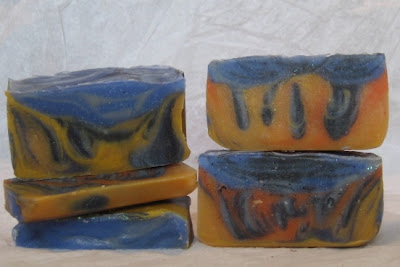I wanted to share some things that I have learned in making soap the past 6 months. In no particular order:
Budgeting:
- Do not bother paying anyone for a lye source. While it may be hard to find locally, it is easy to get online via soap suppliers or my favorite, The Lye Guy. Locally, I buy lye soap at Rural King. However, don't ask for lye, the sales people will look at you cross eyed. Go to the plumbing section and look for Roebic Crystal Drain Opener. I have looked at other stores and Roebic is the only drain opener I have found that is pure enough to use for soap.
- Have a budget! Soap supplies can get pricy.
- Shop around for the best deals. Compare prices at soap suppliers and make sure you consider pros and cons. For instance, Brambleberry includes a free sample of fragrance with every order. Nature's Garden includes a silk flower that has been scented with a fragrance. As fragrances can morph in soaps, the actual product is more useful to me.
Supplies:
- A silicone bread pan makes an awesome soap mold for beginners.
- I upgraded to a 2 pound wooden mold that I bought from brambleberry. I bought http://www.brambleberry.com/ELF-2-lb-Wood-Loaf-Mold-P5239.aspx because I wanted something that was oven safe.
- Only use fragrances that are safe for use in soap. Some candle fragrances are not soap safe. Make sure you check before you buy.
- I bought a crockpot online after goodwill was not fruitful. I wanted one with a removable crock. I wish I had gotten one with a warm setting in addition to low and high because it would give me more temperature options. Don't bother looking for a crockpot with a timer.
Process
- Two pounds became my size of choice.
- MEASURE, Measure, measure!!! Precision matters! You could end up with a soap that is lye heavy or not soap.
- Read. Do research. Rebecca's Soap Deli, Soap Queen, and Loving Soap are my favorite sources.
- Have patience. Soap needs time to cure.
- Clean your workspace before and after you make soap. I keep a bottle of vinegar water with a little essential oil that I use. This is to prevent cross contamination of soap (and food). Also, the debate, "is that lye or is that splenda?" sucks and isn't worth it.
- The few lye burns I have had were mostly caused by poor glove safety. Wear gloves. Wear goggles. I have only had one lye burn caused by static and I also decided to use a flat spatula to transfer lye as opposed to a spoon.
- The lye burns I have had all started with a pleasant warm feeling that changed into a burning sensation. So if you feel a pleasant warm feeling, don't wait for the burn! Rinse it off! I have read that vinegar is not safe to wash off lye because it will create more heat, and that you have to use vinegar to rinse off lye. In my experience, the vinegar stops the burning.









